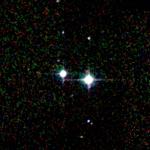tóng-àn:Messier object 40.jpg
Messier_object_40.jpg (150 × 150 像素,檔案佔量: 5 KB,MIME類型: image/jpeg)
|
|
這是對Wikimedia Commons引來的一份檔案。伊佇hia ê kì-su̍t-ia̍h頂面的資訊顯示對下底. |
Khài-iàu
Messier object 40
Messier 40 is a double star with a separation of 53 arc seconds. It was catalogued by Charles Messier in 1764. It is also identified as Winnecke 4 (WNC 4) with position and separation measurements dating back to 1869. There is nothing unusual about the two component stars that make up this object. The two stars are easily visible and resolved in any small telescope. A slow relative motion of the two stars gave the appearance that they were in a slow orbit around each other. In fact their alleged orbital motion was so slow that it was believed that the orbital period was in the range of thousands of years, if indeed this was a true gravitationally bound binary star system.
A fresh investigation of the nature of M40 was undertaken by Richard Nugent in 2002; his results support the hypothesis of an optical double star, i.e. different distances of the two stars: The observed relative proper motion, as measured in separation and position angle, is consistent with a straight, independent motion of the two stars, one crossing between us and the other. From the spectral types provided by Brain Skiff of the Lowell Observatory in 2001, Nugent estimates the absolute magnitudes as Mv=+0.88 and +4.0, masses as 1.1 and 1.2 solar masses for the primary (A) and secondary component (B), and thus derives spectroscopic distances of 1900 +/- 750 and 550 +/- 230 light-years, respectively, the great uncertainties coming from observational inacuracies. This indicates that perhaps the secondary component, B, may be much closer to us than the brighter primary, A.
The numbers imply that if the two components of M40 were a true gravitationally connected binary star system, the period of the orbit would exceed 232,000 years which is unheard of in the binary star community. This orbital period would indicate an actual separation of the pair of some 5,000-7,500 AU's (0.10 light year) which is unrealstic for a binary star system.
Batch
SOURCE: http://www.ipac.caltech.edu/2mass/gallery/messiercat.html
Acknowledgment: Atlas Image [or Atlas Image mosaic] obtained as part of the Two Micron All Sky Survey (2MASS), a joint project of the University of Massachusetts and the Infrared Processing and Analysis Center/California Institute of Technology, funded by the National Aeronautics and Space Administration and the National Science Foundation.
Siū-khoân
| Public domainPublic domainfalsefalse |
| This work has been released into the public domain by its copyright holder, Two Micron All Sky Survey (2MASS). This applies worldwide. 這可能在某些國家不合法,如果是的話: Two Micron All Sky Survey (2MASS)授予任何人有權利使用此作品於任何用途,除受法律約束外,不受任何限制。 Public domainPublic domainfalsefalse |
| Public domainPublic domainfalsefalse |
This image is from the Two Micron All Sky Survey (2MASS) project.
At http://www.ipac.caltech.edu/2mass/gallery/aboutimages.html it says:
2MASS kindly requests acknowledgement in one of the following forms, the longer of which is preferred.
English | español | македонски | português | +/− |
檔案歷史
揤日期/時間,看彼時陣的檔案.
| 日期/ 時間 | 細張圖 | 寸尺 | 用者 | 註解 | |
|---|---|---|---|---|---|
| 現在 | 2007年8月28日 (拜2) 20:47 |  | 150 × 150(5 KB) | wikimediacommons>WilyD | ===Description=== Messier object 050 ===Batch=== '''SOURCE''': http://www.ipac.caltech.edu/2mass/gallery/messiercat.html '''Acknowledgment''': ''Atlas Image [or Atlas Image mosaic] obtained as part of the Two Micron All Sky Survey (2MASS), a joint proje |
影像連結
以下的頁連到這个影像:
元資料
這个檔案有伊的資訊,可能是相機抑掃描機用的。
若改過這个檔案,資訊就無完全對著。
| _error | 0 |
|---|
